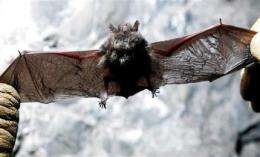Forest Service closes caves to stop bat fungus

(AP) -- The U.S. Forest Service is closing thousands of caves and former mines in national forests in 33 states in an effort to control a fungus that has already killed an estimated 500,000 bats.
Bats have been dying at alarming rates from what scientists call "white-nose syndrome," so-named because it appears as a white powder on the face and wings of hibernating bats.
The problem was first spotted in New York and within two years has spread to caves in West Virginia and Virginia. There's no evidence the fungus is harmful to people.
Researchers believe the fungus is spread from bat to bat, but they have not ruled out the possibility that humans tromping from cave to cave might help to transmit it on their shoes and equipment, said Dennis Krusac, a biologist with the service's Southern region.
"We don't have the answers at this point," he said. "If we have answers in a year or sooner, we can open them back up."
Forest Service biologist Becky Ewing said an emergency order was issued last week for caves in 20 states from Minnesota to Maine. A second order covering the Forest Service's 13-state Southern region should be issued later this month.
The sites will be closed for up to a year, she said.
The orders follow a March request by the U.S. Fish and Wildlife Service for people to voluntarily stay out of caves in 17 states.
Biologists are concerned the fungus could wipe out endangered Indiana, Virginia and Ozark big-eared and gray bats.
Bats play a key role in keeping insects such as mosquitoes under control. Between April and October, they usually eat their body weight in bugs per night. The loss of 500,000 bats means 2.4 million pounds of bugs aren't eaten in a year, Ewing said.
New York caver Peter Haberland said organized caving groups shouldn't object to the closures.
"For a period of a year, most people can deal with that," said Haberland, who serves on the Northeastern Cave Conservancy's board.
He said the order should have little effect in the Northeast since just a few national forests there offer caving and many caves are on private property.
Peter Youngbaer, white nose syndrome liaison for the National Speleological Society, another caving group, said education will be key because many people who explore caves don't belong to organized groups.
"There is a huge concern," he said. "The recreation aspect is probably the least of our concerns."
The Forest Service order says people caught in a cave or mine face up to six months in jail and fines of up to $10,000. Ewing said Forest Service officials will enforce the bans.
Youngbaer said he isn't convinced humans help transmit the fungus, which kills the bats because it affects their hibernation habits, causing them to starve.
A study based on soil samples taken from 200 sites in 30 states should help resolve that question.
"There is no question that it's spreading bat to bat and spreading from bat to bat rapidly," he said. "If it turns out the fungus is living in the caves anyway ... humans moving around doesn't mean anything."
Many of the caves in question are in the 919,000-acre Monongahela National Forest in West Virginia, which this week announced it would extend a ban imposed last year that only affected caves considered to be at high risk for the fungus.
On Friday, the Indiana Department of Natural Resources moved to close caves on state-owned property until April even though the disease has not been found in Indiana.
Last month, officials closed all of the caves in the Great Smoky Mountains National Park. Krusac said the orders do not affect commercial caves on private property.
Officials in the Ozark National Forest are debating whether to impose restrictions on wild cave adventures on the forest's Blanchard Springs Caverns.
©2009 The Associated Press. All rights reserved. This material may not be published, broadcast, rewritten or redistributed.














